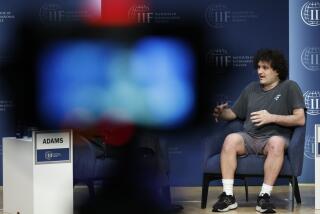Taking a Murky Look at the Darker Side of Bill Gates
- Share via
“The Microsoft File: The Secret Case Against Bill Gates,” by Wendy Goldman Rohm; Random House $25.95
“Barbarians Led by Bill Gates: Microsoft From the Inside,” by Jennifer Edstrom and Marlin Eller; Henry Holt & Co. $23
*
Just as the Justice Department prepares to argue in an upcoming trial that Microsoft unfairly used its software monopoly to protect and extend its empire, a new round of books has come out purporting to tell the “true” story behind Microsoft’s success.
In “The Microsoft File: The Secret Case Against Bill Gates,” journalist Wendy Goldman Rohm portrays Microsoft as a scheming, double-crossing predator out to stomp its opposition into submission.
By contrast, Marlin Eller, a former Microsoft developer, and Jennifer Edstrom, the daughter of Microsoft publicist Pam Edstrom, picture Microsoft as a bumbling, rudderless company that has somehow stumbled its way to success in “Barbarians Led by Bill Gates: Microsoft From the Inside.”
After the dozens of books that have breathlessly chronicled the incredible rise to power of Bill Gates and Microsoft, it is inevitable that there should be a corrective shedding of light on the company’s darker side.
Rohm does the better job of taking on that task with some fairly incendiary evidence, apparently obtained from government regulators, that Microsoft has occasionally engaged in underhanded tactics.
Microsoft competitors have long suspected the company embeds code in its operating system that favors its own software over that of competitors. Old-timers will recall the old ditty, “DOS isn’t done until Lotus won’t run.”
Rohm provides evidence of just such a practice. There is the e-mail, for example, in which Microsoft executive Brad Silverberg explains why developers put an error message in an early version of Windows that was designed to pop up when consumers ran Windows on DR-DOS, a competitor to Microsoft’s MS-DOS software: “What the guy is supposed to do is feel uncomfortable and when he has bugs, suspect the problem is DR-DOS, and then go out to buy MS-DOS,” Silverberg wrote in the e-mail.
There also are more potentially serious accusations. Rohm said federal investigators discovered among the documents they received from Microsoft a note in Gates’ handwriting that says “Purge E-mail.” It is unclear if the note was written before or after authorities ordered Microsoft not to destroy any documents. Rohm has recently reported that the Justice Department is now investigating new charges that Microsoft may have destroyed evidence.
Microsoft dismisses Rohm’s book as fiction.
Unfortunately, Rohm doesn’t help her case by re-creating scenes that presume a knowledge of Gates’ state of mind.
“She was beautiful. It hardly mattered that she was paid,” Rohm begins a chapter that briefly discusses an alleged Gates liaison with a prostitute. “There were times when it seemed that pieces of himself had distilled and separated under the glare of the bare sun,” she continues.
These passages are a small part of the book, but they detract mightily because of the poor prose and because they blur the line between reality and fiction.
“Barbarians” may be more accurate in its account of Microsoft’s foibles, including the rocky start of its online service MSN and failed efforts to develop a computerized home control system.
Eller says his book shows Microsoft’s success was more like white-water rafting than strategic thinking. But if Microsoft makes so many mistakes, why is it so successful? Eller doesn’t explain.
Put the two books together and you do get a picture of Microsoft as a rather mean-spirited company driven as much by the desire to destroy competition as the desire to innovate.
Consider Microsoft’s treatment, described in both books, of Go Corp., a start-up that developed software that could recognize handwriting.
Go has long suspected Microsoft of stealing its technology. Eller, who headed a Microsoft effort to duplicate Go’s technology, admits that Microsoft sent an employee to videotape a demonstration of Go’s handwriting-recognition software. He says his group then used the tape to reverse-engineer Go’s technology.
Eller admits that Microsoft’s handwriting-recognition software was a failure, but he justifies the effort as a way to stop the threat from tiny Go.
“We weren’t trying to sell software, we were trying to prevent other people from selling software,” Eller writes. “They spent $75 million pumping up this market, we spent $4 million shooting them down. They’re toast.”
Rohm describes how Microsoft signed a not-for-disclosure agreement to look at Go’s technology and then distributed the information to numerous Microsoft executives in violation of the contract.
Unfortunately, both books fail to give proper context for what they describe. Rohm offers an account of a rivalry between Gates and Microsoft legal counsel Bill Neukom over the attention of a German Microsoft employee. Even if it’s true, she doesn’t tell us why we should care.
If you want to understand Bill Gates and Microsoft, you’re still better off reading “Gates” by Stephen Mains and Paul Andrews or “Hard Drive,” by James Wallace and Jim Erickson.
For insight into life on the Microsoft campus, read G. Pascal Zachary’s “Show-Stopper,” the account released in 1994.
But earlier books don’t directly address the question of Microsoft’s use of its enormous market power. Rohm does. And if you are ready to skip some of the turgid writing and cut out the many detours, including two silly poems by former Novell Chief Executive Ray Noorda, “The Microsoft File” still contains the most comprehensive treatment of charges being leveled against Microsoft.
It’s too bad Rohm’s account isn’t clearer and more authoritative. We may have to wait until the boxes full of documents generated for the current antitrust case are made public to get the full story.
*
Times staff writer Leslie Helm can be reached via e-mail at leslie.helm@latimes.com.
More to Read
Sign up for our Book Club newsletter
Get the latest news, events and more from the Los Angeles Times Book Club, and help us get L.A. reading and talking.
You may occasionally receive promotional content from the Los Angeles Times.










